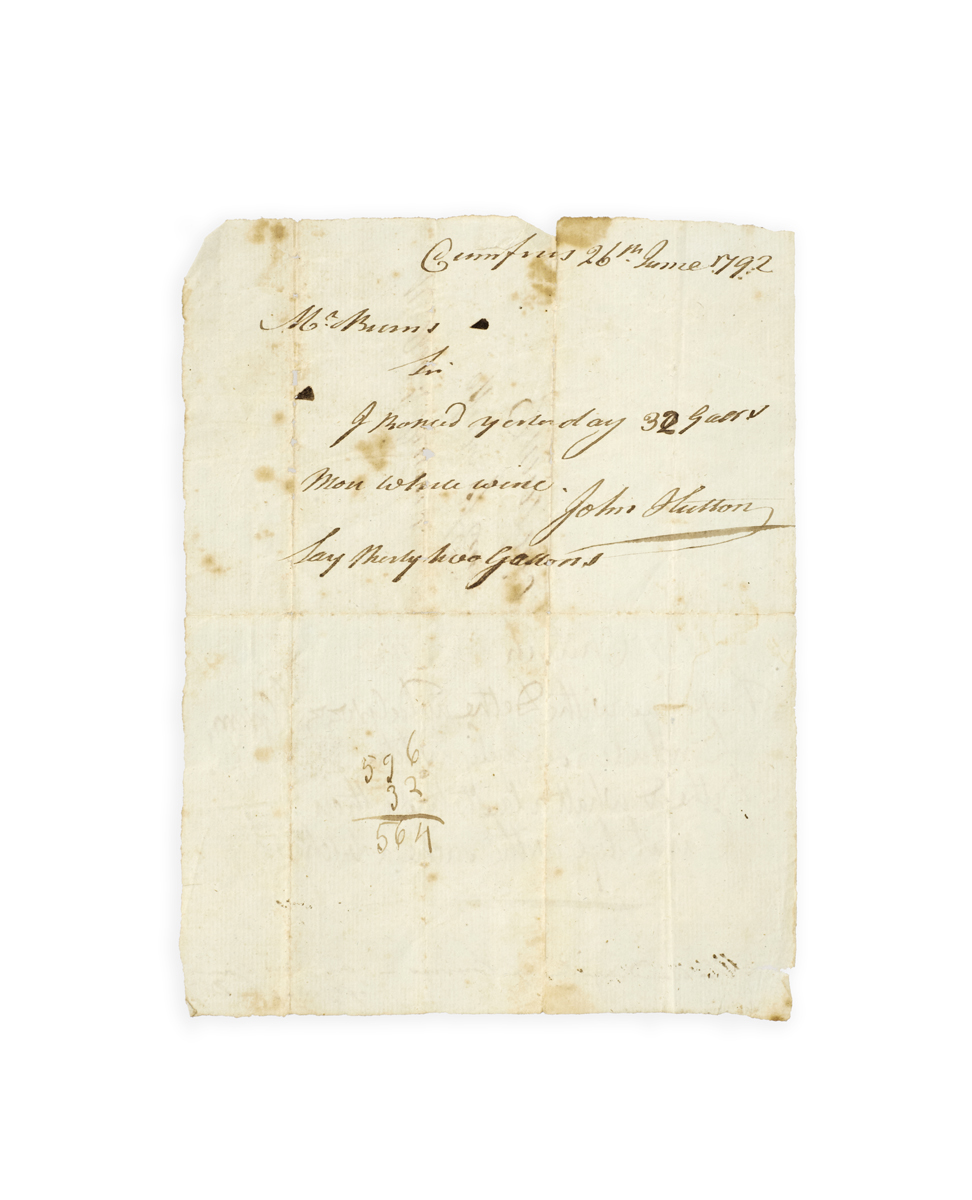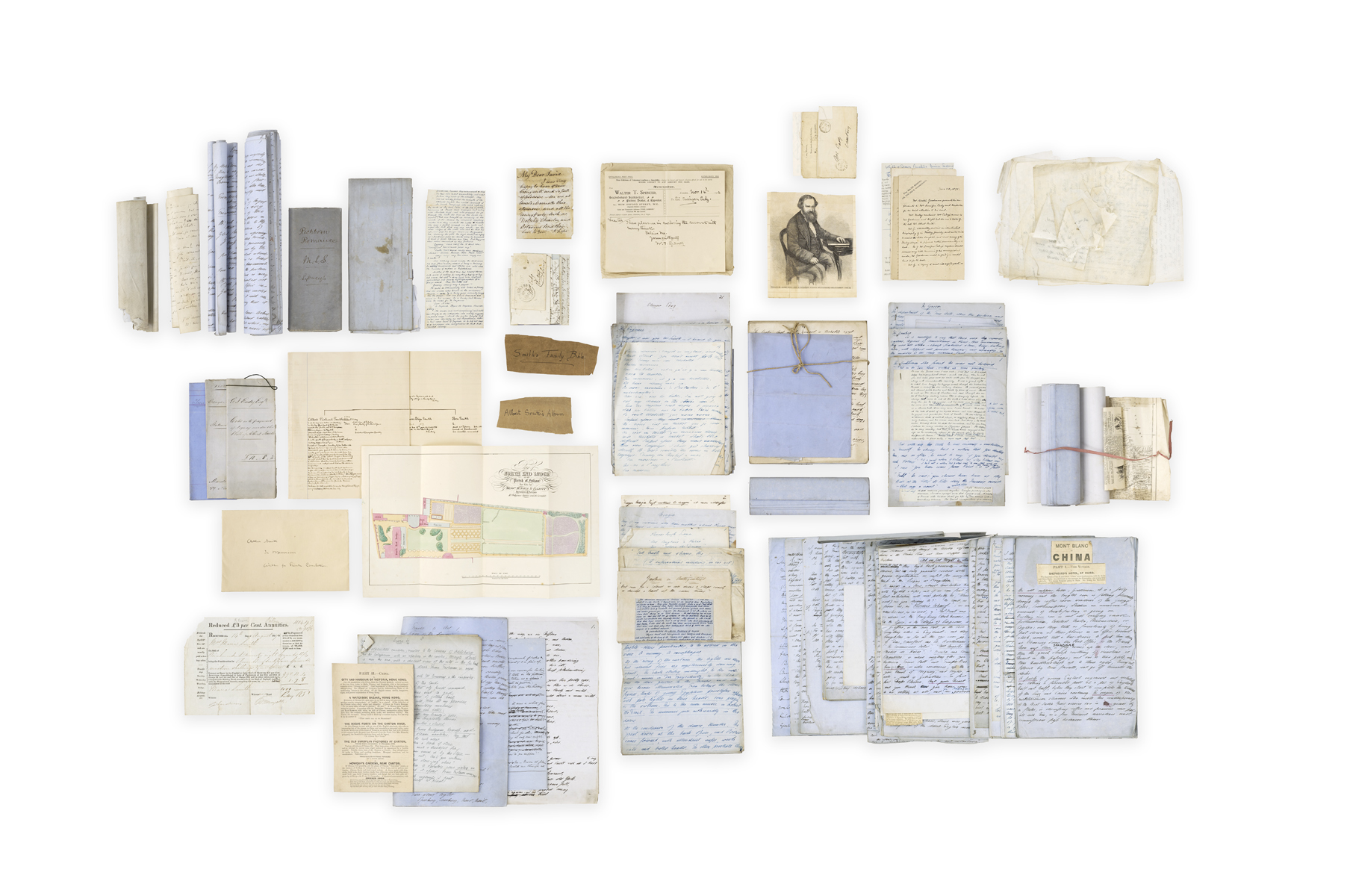

IMPROMPTU BAWDRY – THE EARLIEST HOLOGRAPH
BURNS, Robert.
Autograph verse ‘Epitaph’ to ‘Grizzel Grim’
c. 1792.
1 leaf 8vo, 4 lines, on the integral blank of a short letter written to Burns in his capacity of excise officer for Dumfries by a local alcohol merchant John Hutton, dated 26 June 1792, with a sum in Burns’s hand below; creased where folded, some edge-wear but in good condition, manuscript note below the poem in the hand of Janet Esther Houison Craufurd (m. 1808), with a longer note by her on a separate sheet.
A charming bawdy ‘epitaph’ by Burns, written seemingly impromptu on the back of a scrap paper relating to his job as an exciseman.
Here lyes withe Dethe, aulde Grizzel Grim,
Lincluden’s uggely witche
O Dethe & whatt a taist haste thou
Canst lye withe suche a bitche!
Only recently discovered among the papers at Craufurdland Castle, near Kilmarnock, the present manuscript is the earliest (and the only currently traceable) holograph version of the poem, and confirms that it is an original composition by Burns. Though only a brief skit, it became the inspiration for one of Burns’s best comic ballads, ‘Grim Grizzel is a mighty dame’ (written 1795), which uniquely allied bawdry with the social commentary that increasingly occupied him in the 1790s.
According to the notes here by Janet Craufurd (m. 1808), which echo a separate source mentioned by Kinsley, the subject of Burns’s ‘Epitaph’ was the still-living Grizzel Young (1732?–1809, formerly Craik) of Youngfield, Lincluden, near Dumfries. ‘Mrs Young was certes very ugly – and the heroine of many singular anecdotes – many of which I was witness of in my childhood near Lincluden’. By 1795 some of those anecdotes had inspired the ballad of Grim Grizzel, in which the haughty dame berates her cowherd for wasting manure by letting her kine shite on other land.
In February 1792 Burns was promoted to his last excise post, as port officer for Dumfries. It was an extremely busy position, with over 50 dealers in excise goods (mainly alcohol, tea and tobacco) under his purview, including the John Hutton who writes to Burns here:
Mr Burns
Sir
I Bottled yesterday 302 galls
More white wine. John Hutton
Say thirty two Gallons
Under this Burns has calculated the sum now left in barrels (‘596 − 32 = 564’), his job requiring him to keep tabs on all dutiable goods within his district. When he died in 1796 Burns owed Hutton £1 8s 6d, but it seems more likely that this note is professional and not personal given the quantities involved.
First published in the 1830s in a modernised version, the ‘Epitaph’ appeared in the Henley and Henderson centenary edition of the Poetry (1896) from a holograph MS then in the possession of Lord Rosebery. It sat there alongside the Grizzel ballad, with a note that Burns ‘pickt up’ this ‘ludicrous epitaph … from an old tombstone among the ruins of the ancient Abbey’ in Dunblane. Despite other cases in which ‘Burns has been deliberately (and sometimes playfully) evasive as regards authorship’ (Henderson, Mackey and McIntyre), which would be especially pertinent with a bawdy poem, Kinsley’s critical edition of 1968 takes this at face value. Kinsley prints the text from Henley and Henderson (the source manuscript being untraced), where the faux archaic orthography is different in ten places. The present manuscript (which likely predates the Rosebery MS by at least three years), and the local provenance, confirm a clear Dumfriesshire connection, rendering the ‘Dunblane’ back-story supremely implausible.
See Jonathan Henderson, Pauline Mackay, and Pamela McIntyre, ‘“Epitaph” on Grizzel Grim: a newly-discovered manuscript in the hand of Robert Burns’, Studies in Scottish Literature 41:1.

